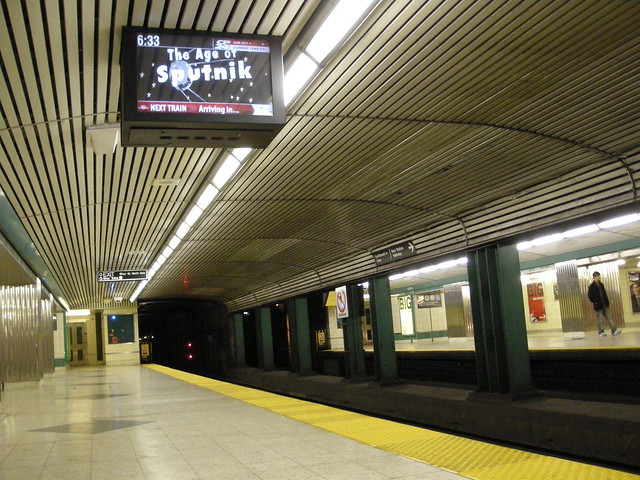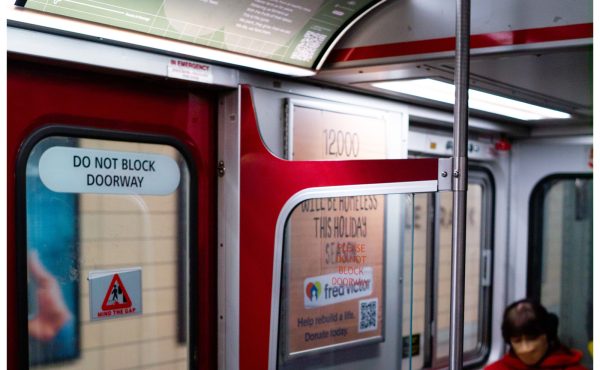
This regular online series will feature interviews with fascinating and influential urban thinkers, with a focus on discussing how Toronto can become a more engaged, accessible, and sustainable city.
Sharon Switzer is director at Art for Commuters. She is also programming curator at Pattison Onestop, which owns and operates TTC subway station monitors. For more than five years, digital screens in subway stations have been displaying artistic and cultural projects. Onestop and Art for Commuters’ latest exhibition is the NFB documentary — One Millionth Tower. Spacing sat down with Sharon to discuss the role art and culture plays in Toronto’s subway network.
Spacing: Where did this idea of using subway platform screens to display artistic work originate?
Switzer: I was introduced to Michael Girgis, the CEO of Onestop, back in 2006. They had just started managing TTC screens and they were looking for content that wasn’t just advertisements. I had recently completed a program at the Canadian Film Centre and decided to market a project to them. We had some conversations and quickly realized that one little project was just a drop in the bucket. In my view, what they needed was someone who could work with them on an ongoing basis to do artistic projects. It took some time but I convinced Michael that displaying art was a good idea. We then began with just a general call for submissions.
Spacing: What is the relationship between Pattison Onestop and Art for Commuters?
Switzer: Art for Commuters is separate and distinct from Onestop. It’s an art collective consisting of myself, and four other people which was founded in 2007 simply as a way to procure funding in support of subway art projects. We needed funding because Onestop was offering only screen time and we wanted to pay artists for their work. Onestop’s role is to provide the media system and the necessary backend technical and creative support. They also help by designing the calls for submissions we place on the network as well as the technical “heavy lifting” of getting artwork from the artist on to station screens.
Spacing: What projects have you exhibited in the last five years?
Switzer: We run four major projects a year. There is the Toronto Urban Film Festival (TUFF) in September. We also do a big, month long photo exhibition as part of the Contact Photography Festival. We do a Nuit Blanche project where Onestop devotes 12 consecutive hours to artwork. For the coming year, we’re working with an artist who’s planning a generative artwork based on transit data. It will be a data visualization piece on how busses move across the city. I’m continuing to work with Shawn Micallef on Stroll City, which is based on his book Stroll. It’s a twitter project where Shawn tweets about Toronto and we get other people to tweet their observations about the city too. We’ve also worked with Critical Art ensembles that created these 10 second long “interventions” that had the appearance of ads but were actually very critical and thought provoking.
Spacing: Are there varieties of art, which are too risqué to exhibit?
Switzer: Yes, the TTC has a set body of rules. We can’t show full frontal nudity or anything violent. We had to disqualify a great little film from TUFF because of its simulated violence. We can’t display anything with profanity and nothing disparaging towards the TTC. Graffiti is a prohibited theme because it might give people ideas.
Spacing: Presently, you’re collaborating with the National Film Board and director Katerina Cizek. How did that come about?
Switzer: I heard Kat speak about her documentary High Rise at a conference. I was incredibly impressed with the project and we began discussing the possibility of exhibiting her work. Art for Commuters’ had interest in the project because it referenced people outside of the downtown core. The subject of people living in high-rises around the world really opened up a whole new audience for us. When Kat started working on the Toronto specific One Millionth Tower, I told her I wanted to showcase it.
Spacing: Have you utilized subway poster ad space at all?
Switzer: Now that Pattison owns Onestop, I have occasional access to poster space too. The NFB project is my first time using subway posters but I’m planning to use them again for Contact. One Millionth Tower is a two-fold project where the screens have six animations, which cycle through every ten minutes and billboard ad space is occupied by four different, specially made posters. Katerina and I decided that the posters for One Millionth Tower needed to be artwork and not just advertisements for an art project. So she designed the posters with that in mind.
Spacing: What projects are on the horizon for Onestop?
Switzer: We’re working with John Greyson at York University to do a serial murder mystery in the style of an old-fashioned radio serial. A new story element is going to be added everyday for two months. Commuters will be able to watch and gradually build a narrative around the clues. We hope that people will be looking to the screens for each new part of the mystery. I’m increasingly looking to work with community groups so long as they can present strong work. Film festivals are still coming to me; in fact we just began collaborating with Imaginative.
Spacing: What advantages do you think the TTC and its subway network offers artists in terms of publicity and exposure?
Switzer: There are over one million people who move through the subway system daily. Therefore, there are over one million people who potentially watch TTC screens and see subway station posters. There’s also this element of bringing art to the people. It’s potentially very powerful to bring art into a space where people conduct their daily activities, especially when people are not expecting it. When you see something you’re not expecting, it affects you differently than if you know what you’re in for.
Photo by Neal Jennings




